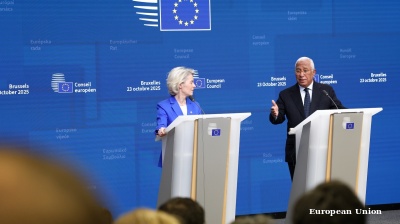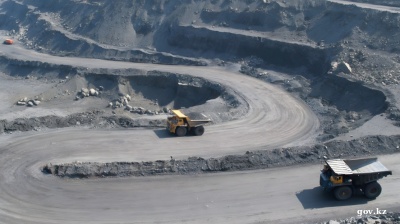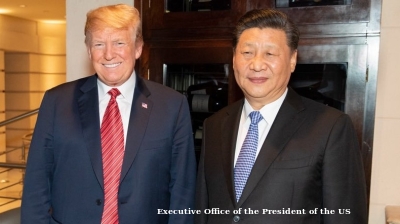In the early hours of September 7 Russia hit the main office of the Ukrainian government, the Cabinet of Ministers where Ukraine’s Prime Minister Yuliia Svyrydenko has her offices on Khreshchatyk in the heart of Kyiv. It is the first time Russia has targeted Ukraine government office buildings as Russian President Vladimir Putin takes his attacks on civilian targets up another notch.
Russia attacked with reported 805 drones and 13 missiles in the largest strike in this war. Two civilians are reported killed in Kyiv – a baby and her mother. Strikes hit primarily industrial plants, critical infrastructure and undisclosed targets in Kyiv located in the historic Pecherskyi district, Odesa, Kryvyi Rih, Dnipro, Zaporizhzhia and other locations.
"Such killings now, when real diplomacy could have already begun long ago, are a deliberate crime and a prolongation of the war," Zelenskiy said in a post on X, issuing a fresh appeal to allies to strengthen Ukrainian air defences.
Russia’s defense ministry said it struck defense industry and transport infrastructure, weapons depots and military airfields, among other targets, Bloomberg reports.

The Armed Forces of Ukraine (AFU) reported that it has shot down about three quarters of the drones, but most of the missiles reached their targets. A nine-story apartment block in one of Kyiv’s districts sustained heavy damage, with several floors partially destroyed, authorities said.
“This morning, rescue teams are working across Ukraine after an overnight barrage of Russian missiles and drones struck Kyiv, Kryvyi Rih, Dnipro, Kremenchuk, and Odesa,” Svyrydenko said in a post on social media.
“Residential buildings, government offices, and civilian infrastructure were deliberately targeted. At least two people have been killed and dozens injured.
“For the first time, the building of the Ukrainian Government sustained direct damage – its roof and upper floors hit in the enemy attack. Firefighters are extinguishing the blaze, and I thank them for their courage and dedication.
“We will rebuild what has been destroyed. But the lives lost cannot be restored. Russia continues to terrorize and murder our people every single day.
“The world must answer this terror not with words alone, but with decisive action. Sanctions pressure must be intensified, above all against Russian oil and gas. New restrictions are needed that will strike at the Kremlin’s military machine.
“And most importantly, Ukraine needs weapons. Only strength can stop the terror and prevent Russia from killing Ukrainians every day,” the Prime Minister concluded.
Refineries and pipelines
Rosneft's Ryazan refinery shut down its main, most powerful AT-6 primary unit on September 5 after a Ukraine attack caused a fire Reuters reported. The region's governor, Pavel Malkov, reported on his Telegram channel that "eight UAVs were shot down by air defence and electronic warfare systems over the territory of the Ryazan region... The debris fell on the territory of an industrial enterprise, the consequences are being eliminated."
However, the primary unit AVT-4 with a capacity of 11,400 tons per day (23% of the refinery’s capacity) is already back in operation at the Ryazan Oil Refinery Complex after repairs, according to reports.
Ukraine has hit a total of ten large refineries in the last month and a total of 50, many of them repeatedly, since the start of the campaign earlier this summer.
Ukraine attacked the Druzhba oil pipeline in Russia's Bryansk region for the fourth time in a month, inflicting "comprehensive fire damage", the commander of its drone forces, Robert Brovdi, said on Telegram said on September 7.
Ukraine has hit the following refinereis in the last 36 days:
1. Novokuibyshevsky
2. Ryazansky
3. Afipsky
4. Saratovsky
5. Volgogradsky
6. Syzransky
7. Novoshakhtinsky
8. Kuibyshkovsky
9. Krasnodarsky
10. Ilsky
Escalating arms race
Ironically, the US withdrawal from the war and Europe’s inability to pay for all the new US weapons Ukraine needs has led to an escalation in the ferocity of Ukraine’s attacks on Russia as it produces more, and more powerful, weapons of its own.
The one advantage of the US withdrawal from the war is that Western restrictions on hitting targets inside Russia – especially oil assets – have also disappeared. Bankova is taking the war to Russia and as oil sanctions have been ineffective it is now targeting Russian refineries with repeated strikes. Ukraine has turned Russia’s vast size, which has previously military advantage, into its Achilles’ heel
With some 70% of its air defence systems deployed in Ukraine and the remaining 30% tasked with defending key military sites in Russia or government buildings in Moscow, the Kremlin simply doesn’t have enough air defence resources to protect every refinery, oil pipeline or pumping station spread across its vast territory.
And the constant attacks appear to be depleting Russia’s store of air defence ammo, turning Russia’s own tactics back on itself. One sign of that is Ukraine has reintroduced the use of the Turkish-made Bayraktar TB2 drones that were first used in October 2021 after Russia broke ceasefire agreements in Donbas before the war. Their use was quickly abandoned after war broke out as Russia developed electronic warfare (EW) and anti-drone defences to take them down. Now it appears holes are spreading in Russia’s territorial air defences that are big enough to make the TB2 drones effective again.

Zelenskiy declared that Ukraine now meets 60% of its weapons needs from its own production, up from 40% earlier this year. Ukraine has been investing heavily in arms production with the help of its western partners under the so-called Danish model.
Bankova also announced last week that it was increasing the production of its new Flamingo cruise missile from seven per day to as many as 20 in the coming months that could be a game changer as they bring many more valuable targets inside Russia into range.
However, Russia is also continuing to invest in expanding its arms production. Ukraine's Main Directorate of Intelligence (HUR) said on September 5 that it believes Russia can now produce 2,700 drones a month as well as 1,200 missiles a year as the intensity of its drone and missile attacks increases five-fold as a missile war gets under way.
Russia is now the only country that independently produces 100% of aircraft components, the head of Rostec Sergey Chemezov told Izvestia at the ODK Kuznetsov plant in Samara.
"All countries, all aircraft manufacturers, of course, have a huge number of component-supplying countries. No one makes everything completely 100% themselves," Chemezov noted.
The West tried to cut Russia from crucial missile inputs with its technology sanctions, but those have largely failed as first Russia found workarounds but now is increasingly being supplied with Chinese technology.
News
_1761305900.jpg)
Latin America edges up growth forecasts but remains trapped in low gear, ECLAC says
Latin America and the Caribbean will expand 2.4% this year, the Economic Commission for Latin America and the Caribbean said, marking the second upward revision since April but pointing to the region's struggle to escape chronically weak growth.

Palestinian ambassador pledges Iraqi embassy in Jerusalem
Palestinian ambassador pledges to open Iraqi embassy in Jerusalem as Iraq lays foundation stone for Palestinian ambassador's residence in Baghdad's new diplomatic quarter covering 300 hectares.

EU pledges ongoing support for Ukraine, defers decision on Russian assets
European Union leaders pledged continued financial backing for Ukraine over the next two years, but delayed a decision on tapping billions of euros in frozen Russian assets to fund Kyiv’s defence

Trump Administration striving to strike critical minerals deal with Kazakhstan
Pushing for US firm to win rights to develop major tungsten deposits.




